Comprehensive Nursing Case Study: ASD Repair, Pain, and Recovery
VerifiedAdded on 2023/06/10
|6
|1255
|297
Case Study
AI Summary
This case study presents a nursing care plan for a patient recovering from Arterial Septal Defect (ASD) repair surgery. The patient experiences post-operative pain, constipation, and sleep deprivation. Nursing diagnoses include acute pain related to the surgery, constipation due to medication side effects, and sleep deprivation related to post-op pain. The care plan outlines specific interventions such as pain management through medication and deep breathing exercises, stool softeners for constipation, and strategies for improving sleep quality. The interventions also focus on monitoring vital signs, medication side effects, and educating the patient and family about the importance of medication adherence, exercises, and proper diet. The goal is to manage pain, reduce adverse drug effects, and improve the patient's overall well-being during the recovery process.
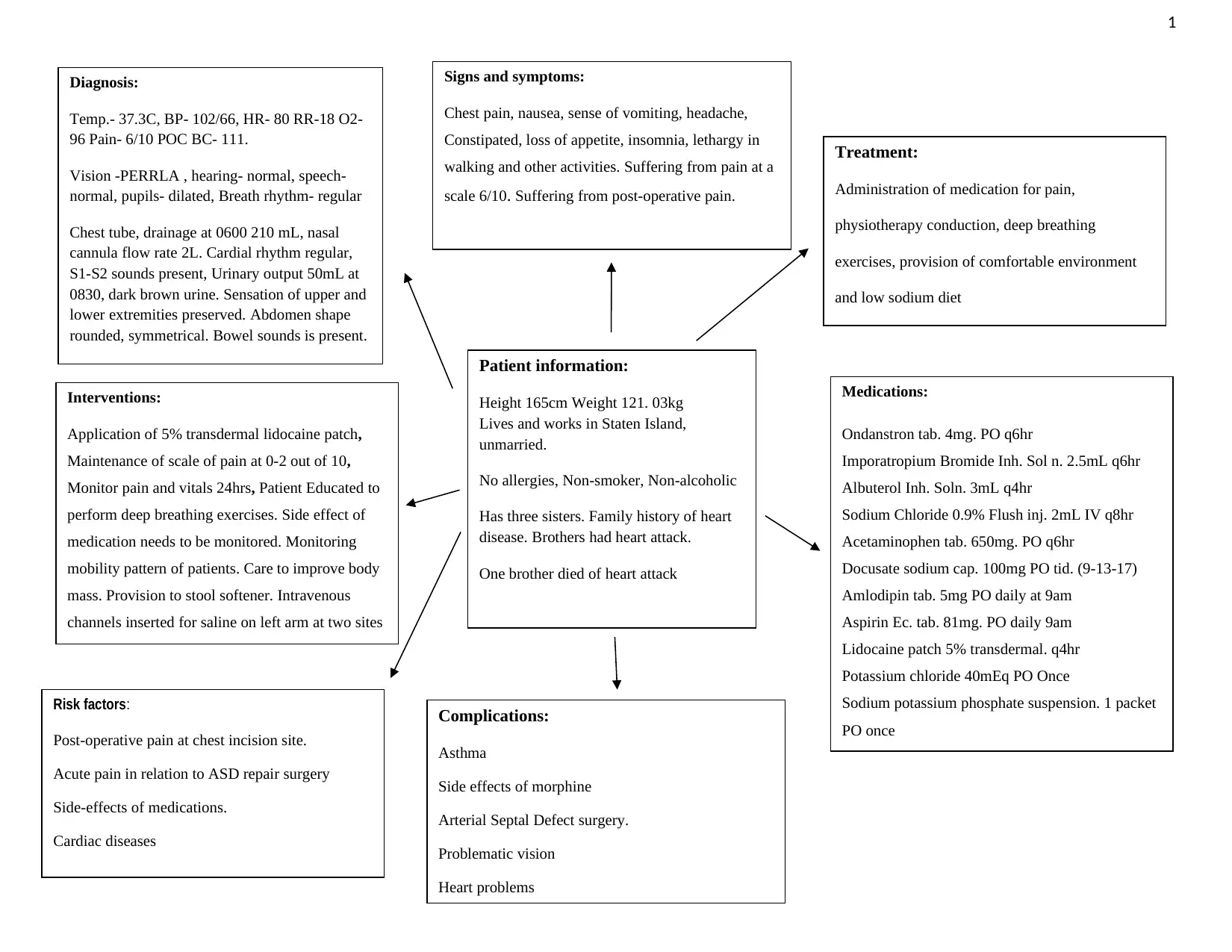
1
Risk factors:
Post-operative pain at chest incision site.
Acute pain in relation to ASD repair surgery
Side-effects of medications.
Cardiac diseases
Complications:
Asthma
Side effects of morphine
Arterial Septal Defect surgery.
Problematic vision
Heart problems
Diagnosis:
Temp.- 37.3C, BP- 102/66, HR- 80 RR-18 O2-
96 Pain- 6/10 POC BC- 111.
Vision -PERRLA , hearing- normal, speech-
normal, pupils- dilated, Breath rhythm- regular
Chest tube, drainage at 0600 210 mL, nasal
cannula flow rate 2L. Cardial rhythm regular,
S1-S2 sounds present, Urinary output 50mL at
0830, dark brown urine. Sensation of upper and
lower extremities preserved. Abdomen shape
rounded, symmetrical. Bowel sounds is present.
Patient information:
Height 165cm Weight 121. 03kg
Lives and works in Staten Island,
unmarried.
No allergies, Non-smoker, Non-alcoholic
Has three sisters. Family history of heart
disease. Brothers had heart attack.
One brother died of heart attack
Medications:
Ondanstron tab. 4mg. PO q6hr
Imporatropium Bromide Inh. Sol n. 2.5mL q6hr
Albuterol Inh. Soln. 3mL q4hr
Sodium Chloride 0.9% Flush inj. 2mL IV q8hr
Acetaminophen tab. 650mg. PO q6hr
Docusate sodium cap. 100mg PO tid. (9-13-17)
Amlodipin tab. 5mg PO daily at 9am
Aspirin Ec. tab. 81mg. PO daily 9am
Lidocaine patch 5% transdermal. q4hr
Potassium chloride 40mEq PO Once
Sodium potassium phosphate suspension. 1 packet
PO once
Ketorolac inj. 7.5mg IV push q4h
Signs and symptoms:
Chest pain, nausea, sense of vomiting, headache,
Constipated, loss of appetite, insomnia, lethargy in
walking and other activities. Suffering from pain at a
scale 6/10. Suffering from post-operative pain.
Treatment:
Administration of medication for pain,
physiotherapy conduction, deep breathing
exercises, provision of comfortable environment
and low sodium diet
Interventions:
Application of 5% transdermal lidocaine patch,
Maintenance of scale of pain at 0-2 out of 10,
Monitor pain and vitals 24hrs, Patient Educated to
perform deep breathing exercises. Side effect of
medication needs to be monitored. Monitoring
mobility pattern of patients. Care to improve body
mass. Provision to stool softener. Intravenous
channels inserted for saline on left arm at two sites
Risk factors:
Post-operative pain at chest incision site.
Acute pain in relation to ASD repair surgery
Side-effects of medications.
Cardiac diseases
Complications:
Asthma
Side effects of morphine
Arterial Septal Defect surgery.
Problematic vision
Heart problems
Diagnosis:
Temp.- 37.3C, BP- 102/66, HR- 80 RR-18 O2-
96 Pain- 6/10 POC BC- 111.
Vision -PERRLA , hearing- normal, speech-
normal, pupils- dilated, Breath rhythm- regular
Chest tube, drainage at 0600 210 mL, nasal
cannula flow rate 2L. Cardial rhythm regular,
S1-S2 sounds present, Urinary output 50mL at
0830, dark brown urine. Sensation of upper and
lower extremities preserved. Abdomen shape
rounded, symmetrical. Bowel sounds is present.
Patient information:
Height 165cm Weight 121. 03kg
Lives and works in Staten Island,
unmarried.
No allergies, Non-smoker, Non-alcoholic
Has three sisters. Family history of heart
disease. Brothers had heart attack.
One brother died of heart attack
Medications:
Ondanstron tab. 4mg. PO q6hr
Imporatropium Bromide Inh. Sol n. 2.5mL q6hr
Albuterol Inh. Soln. 3mL q4hr
Sodium Chloride 0.9% Flush inj. 2mL IV q8hr
Acetaminophen tab. 650mg. PO q6hr
Docusate sodium cap. 100mg PO tid. (9-13-17)
Amlodipin tab. 5mg PO daily at 9am
Aspirin Ec. tab. 81mg. PO daily 9am
Lidocaine patch 5% transdermal. q4hr
Potassium chloride 40mEq PO Once
Sodium potassium phosphate suspension. 1 packet
PO once
Ketorolac inj. 7.5mg IV push q4h
Signs and symptoms:
Chest pain, nausea, sense of vomiting, headache,
Constipated, loss of appetite, insomnia, lethargy in
walking and other activities. Suffering from pain at a
scale 6/10. Suffering from post-operative pain.
Treatment:
Administration of medication for pain,
physiotherapy conduction, deep breathing
exercises, provision of comfortable environment
and low sodium diet
Interventions:
Application of 5% transdermal lidocaine patch,
Maintenance of scale of pain at 0-2 out of 10,
Monitor pain and vitals 24hrs, Patient Educated to
perform deep breathing exercises. Side effect of
medication needs to be monitored. Monitoring
mobility pattern of patients. Care to improve body
mass. Provision to stool softener. Intravenous
channels inserted for saline on left arm at two sites
Paraphrase This Document
Need a fresh take? Get an instant paraphrase of this document with our AI Paraphraser
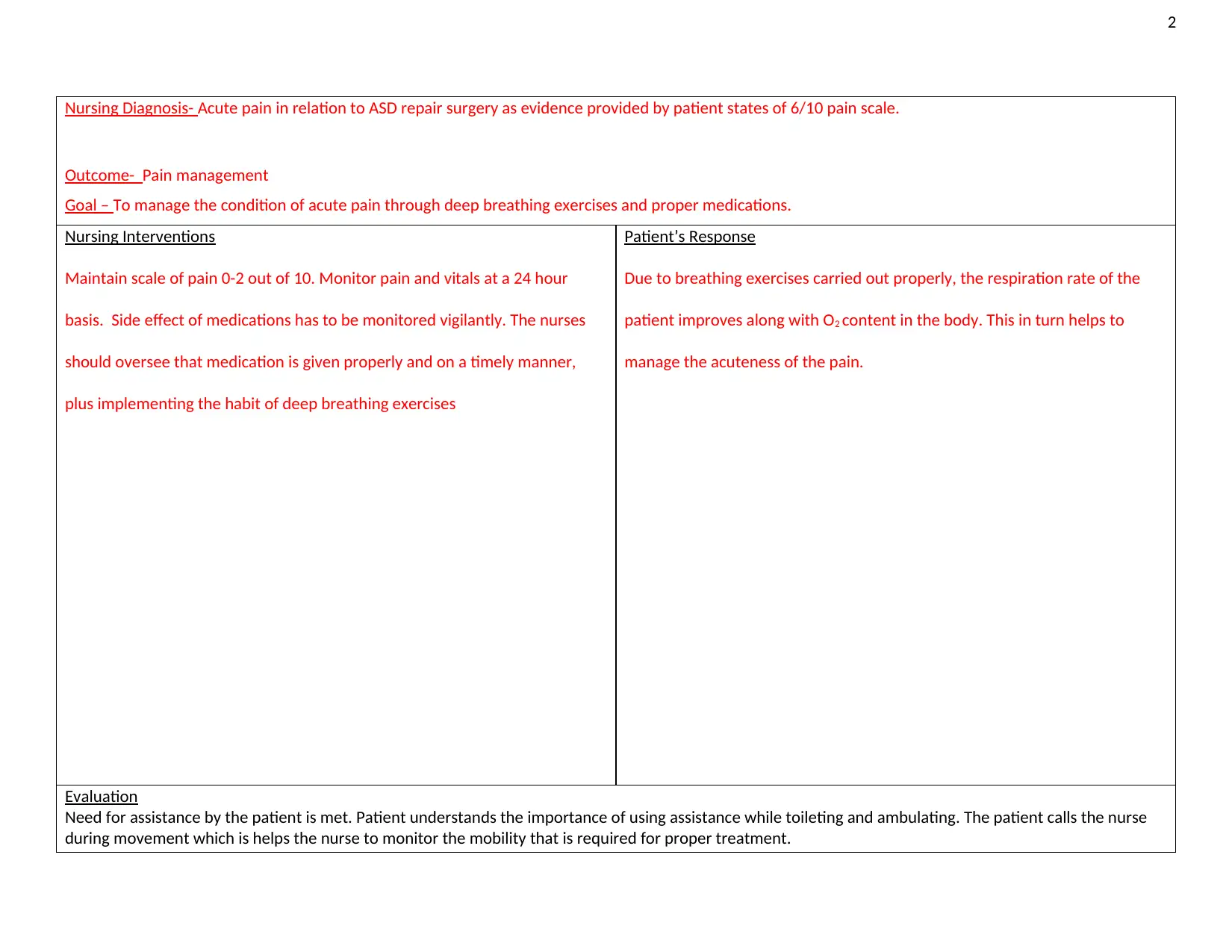
2
Nursing Diagnosis- Acute pain in relation to ASD repair surgery as evidence provided by patient states of 6/10 pain scale.
Outcome- Pain management
Goal – To manage the condition of acute pain through deep breathing exercises and proper medications.
Nursing Interventions
Maintain scale of pain 0-2 out of 10. Monitor pain and vitals at a 24 hour
basis. Side effect of medications has to be monitored vigilantly. The nurses
should oversee that medication is given properly and on a timely manner,
plus implementing the habit of deep breathing exercises
Patient’s Response
Due to breathing exercises carried out properly, the respiration rate of the
patient improves along with O2 content in the body. This in turn helps to
manage the acuteness of the pain.
Evaluation
Need for assistance by the patient is met. Patient understands the importance of using assistance while toileting and ambulating. The patient calls the nurse
during movement which is helps the nurse to monitor the mobility that is required for proper treatment.
Nursing Diagnosis- Acute pain in relation to ASD repair surgery as evidence provided by patient states of 6/10 pain scale.
Outcome- Pain management
Goal – To manage the condition of acute pain through deep breathing exercises and proper medications.
Nursing Interventions
Maintain scale of pain 0-2 out of 10. Monitor pain and vitals at a 24 hour
basis. Side effect of medications has to be monitored vigilantly. The nurses
should oversee that medication is given properly and on a timely manner,
plus implementing the habit of deep breathing exercises
Patient’s Response
Due to breathing exercises carried out properly, the respiration rate of the
patient improves along with O2 content in the body. This in turn helps to
manage the acuteness of the pain.
Evaluation
Need for assistance by the patient is met. Patient understands the importance of using assistance while toileting and ambulating. The patient calls the nurse
during movement which is helps the nurse to monitor the mobility that is required for proper treatment.
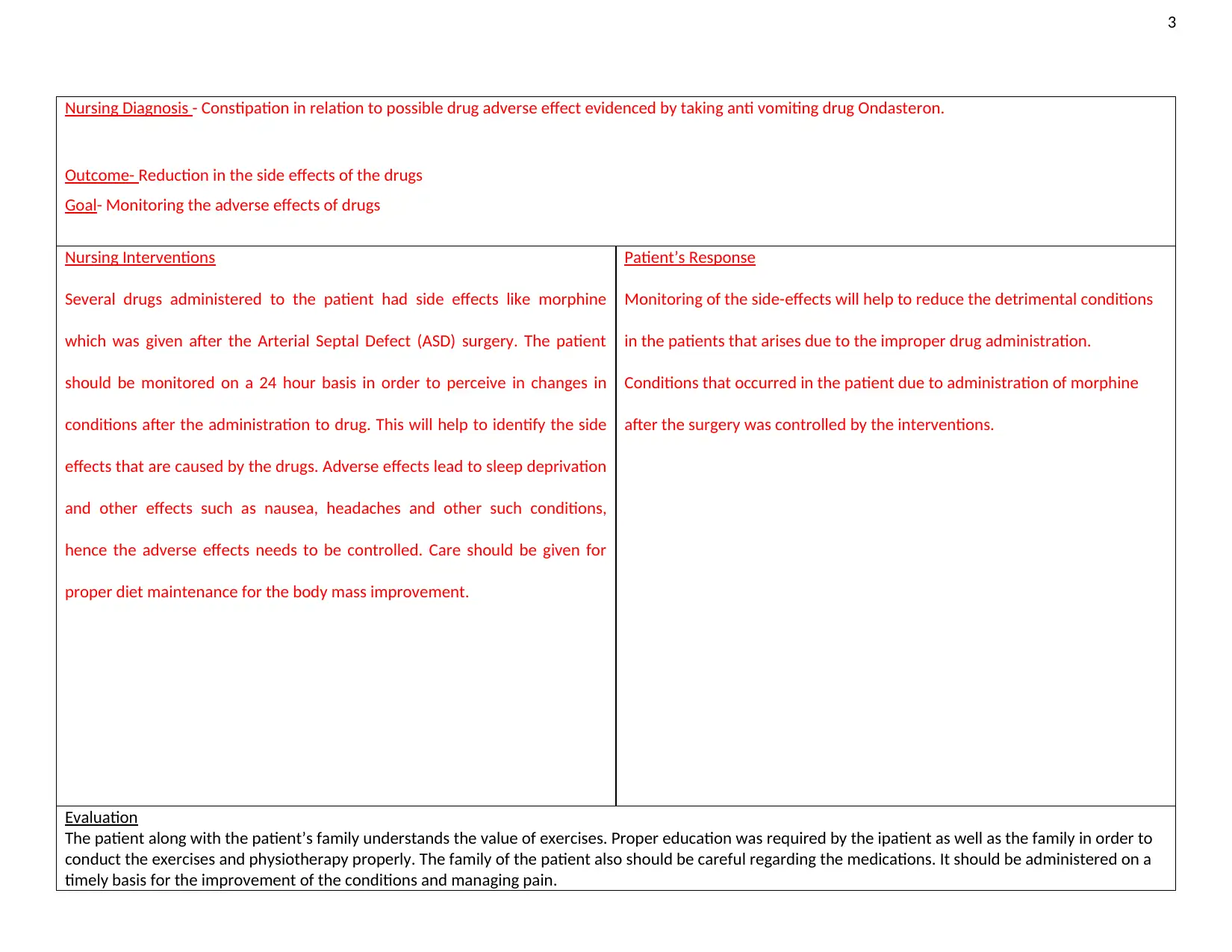
3
Nursing Diagnosis - Constipation in relation to possible drug adverse effect evidenced by taking anti vomiting drug Ondasteron.
Outcome- Reduction in the side effects of the drugs
Goal- Monitoring the adverse effects of drugs
Nursing Interventions
Several drugs administered to the patient had side effects like morphine
which was given after the Arterial Septal Defect (ASD) surgery. The patient
should be monitored on a 24 hour basis in order to perceive in changes in
conditions after the administration to drug. This will help to identify the side
effects that are caused by the drugs. Adverse effects lead to sleep deprivation
and other effects such as nausea, headaches and other such conditions,
hence the adverse effects needs to be controlled. Care should be given for
proper diet maintenance for the body mass improvement.
Patient’s Response
Monitoring of the side-effects will help to reduce the detrimental conditions
in the patients that arises due to the improper drug administration.
Conditions that occurred in the patient due to administration of morphine
after the surgery was controlled by the interventions.
Evaluation
The patient along with the patient’s family understands the value of exercises. Proper education was required by the ipatient as well as the family in order to
conduct the exercises and physiotherapy properly. The family of the patient also should be careful regarding the medications. It should be administered on a
timely basis for the improvement of the conditions and managing pain.
Nursing Diagnosis - Constipation in relation to possible drug adverse effect evidenced by taking anti vomiting drug Ondasteron.
Outcome- Reduction in the side effects of the drugs
Goal- Monitoring the adverse effects of drugs
Nursing Interventions
Several drugs administered to the patient had side effects like morphine
which was given after the Arterial Septal Defect (ASD) surgery. The patient
should be monitored on a 24 hour basis in order to perceive in changes in
conditions after the administration to drug. This will help to identify the side
effects that are caused by the drugs. Adverse effects lead to sleep deprivation
and other effects such as nausea, headaches and other such conditions,
hence the adverse effects needs to be controlled. Care should be given for
proper diet maintenance for the body mass improvement.
Patient’s Response
Monitoring of the side-effects will help to reduce the detrimental conditions
in the patients that arises due to the improper drug administration.
Conditions that occurred in the patient due to administration of morphine
after the surgery was controlled by the interventions.
Evaluation
The patient along with the patient’s family understands the value of exercises. Proper education was required by the ipatient as well as the family in order to
conduct the exercises and physiotherapy properly. The family of the patient also should be careful regarding the medications. It should be administered on a
timely basis for the improvement of the conditions and managing pain.
⊘ This is a preview!⊘
Do you want full access?
Subscribe today to unlock all pages.

Trusted by 1+ million students worldwide
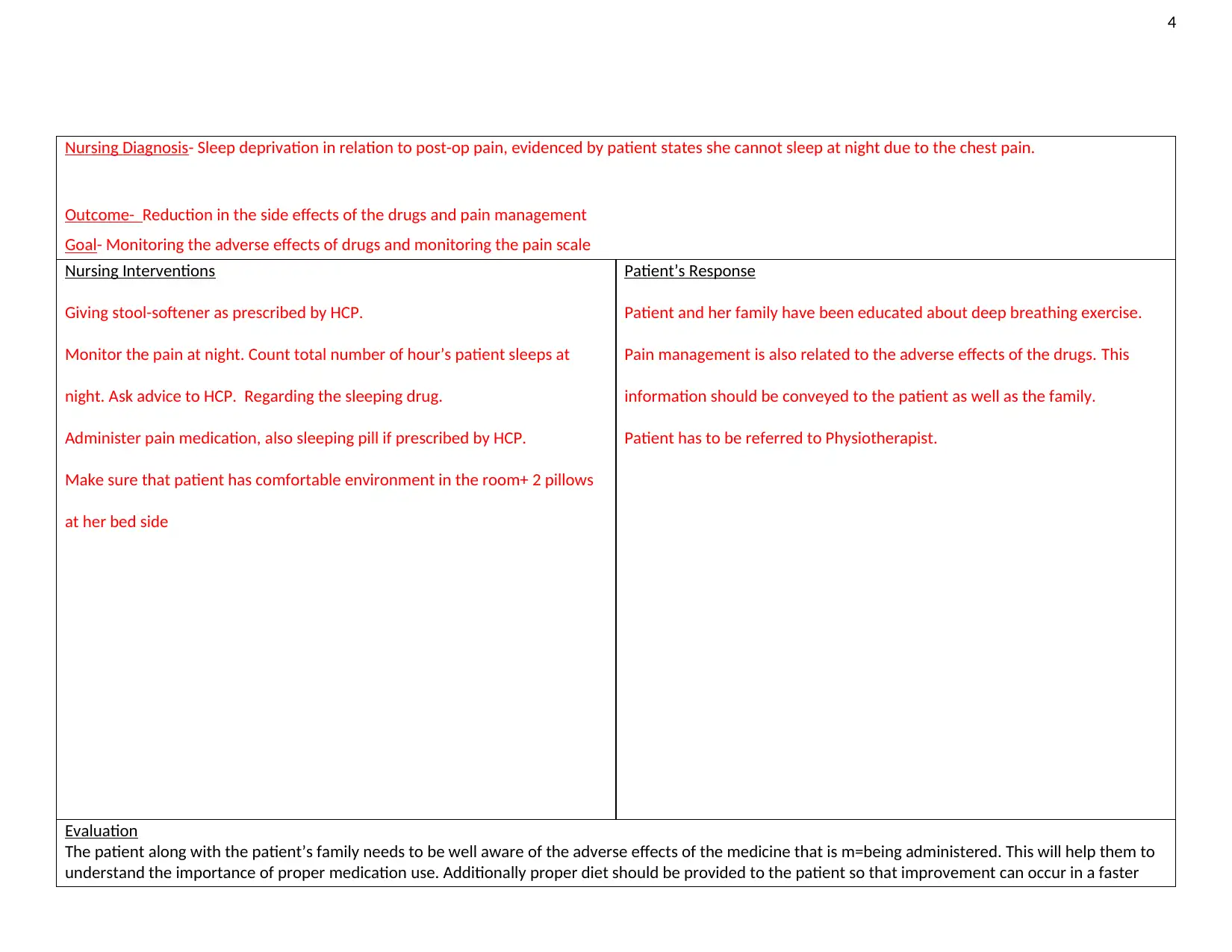
4
Nursing Diagnosis- Sleep deprivation in relation to post-op pain, evidenced by patient states she cannot sleep at night due to the chest pain.
Outcome- Reduction in the side effects of the drugs and pain management
Goal- Monitoring the adverse effects of drugs and monitoring the pain scale
Nursing Interventions
Giving stool-softener as prescribed by HCP.
Monitor the pain at night. Count total number of hour’s patient sleeps at
night. Ask advice to HCP. Regarding the sleeping drug.
Administer pain medication, also sleeping pill if prescribed by HCP.
Make sure that patient has comfortable environment in the room+ 2 pillows
at her bed side
Patient’s Response
Patient and her family have been educated about deep breathing exercise.
Pain management is also related to the adverse effects of the drugs. This
information should be conveyed to the patient as well as the family.
Patient has to be referred to Physiotherapist.
Evaluation
The patient along with the patient’s family needs to be well aware of the adverse effects of the medicine that is m=being administered. This will help them to
understand the importance of proper medication use. Additionally proper diet should be provided to the patient so that improvement can occur in a faster
Nursing Diagnosis- Sleep deprivation in relation to post-op pain, evidenced by patient states she cannot sleep at night due to the chest pain.
Outcome- Reduction in the side effects of the drugs and pain management
Goal- Monitoring the adverse effects of drugs and monitoring the pain scale
Nursing Interventions
Giving stool-softener as prescribed by HCP.
Monitor the pain at night. Count total number of hour’s patient sleeps at
night. Ask advice to HCP. Regarding the sleeping drug.
Administer pain medication, also sleeping pill if prescribed by HCP.
Make sure that patient has comfortable environment in the room+ 2 pillows
at her bed side
Patient’s Response
Patient and her family have been educated about deep breathing exercise.
Pain management is also related to the adverse effects of the drugs. This
information should be conveyed to the patient as well as the family.
Patient has to be referred to Physiotherapist.
Evaluation
The patient along with the patient’s family needs to be well aware of the adverse effects of the medicine that is m=being administered. This will help them to
understand the importance of proper medication use. Additionally proper diet should be provided to the patient so that improvement can occur in a faster
Paraphrase This Document
Need a fresh take? Get an instant paraphrase of this document with our AI Paraphraser
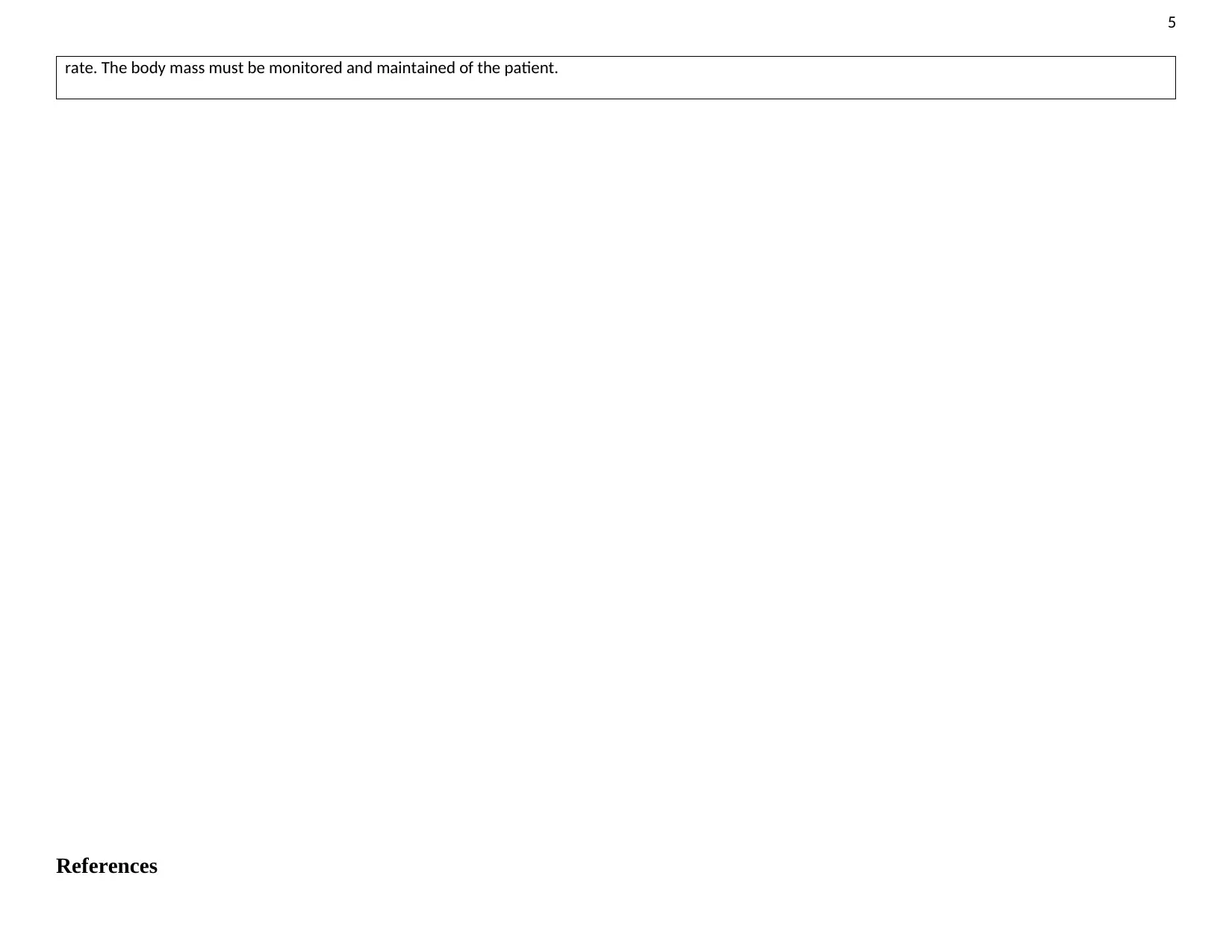
5
rate. The body mass must be monitored and maintained of the patient.
References
rate. The body mass must be monitored and maintained of the patient.
References
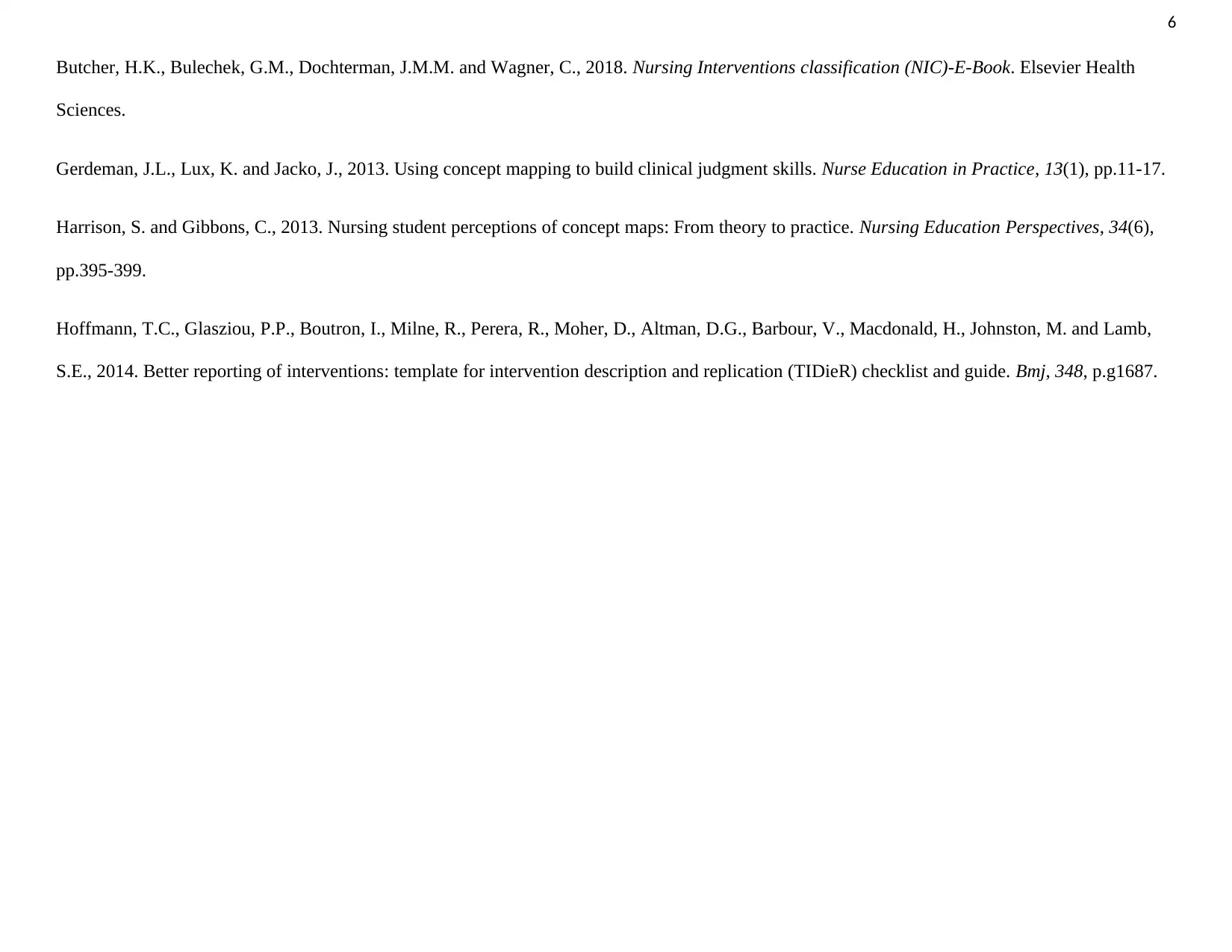
6
Butcher, H.K., Bulechek, G.M., Dochterman, J.M.M. and Wagner, C., 2018. Nursing Interventions classification (NIC)-E-Book. Elsevier Health
Sciences.
Gerdeman, J.L., Lux, K. and Jacko, J., 2013. Using concept mapping to build clinical judgment skills. Nurse Education in Practice, 13(1), pp.11-17.
Harrison, S. and Gibbons, C., 2013. Nursing student perceptions of concept maps: From theory to practice. Nursing Education Perspectives, 34(6),
pp.395-399.
Hoffmann, T.C., Glasziou, P.P., Boutron, I., Milne, R., Perera, R., Moher, D., Altman, D.G., Barbour, V., Macdonald, H., Johnston, M. and Lamb,
S.E., 2014. Better reporting of interventions: template for intervention description and replication (TIDieR) checklist and guide. Bmj, 348, p.g1687.
Butcher, H.K., Bulechek, G.M., Dochterman, J.M.M. and Wagner, C., 2018. Nursing Interventions classification (NIC)-E-Book. Elsevier Health
Sciences.
Gerdeman, J.L., Lux, K. and Jacko, J., 2013. Using concept mapping to build clinical judgment skills. Nurse Education in Practice, 13(1), pp.11-17.
Harrison, S. and Gibbons, C., 2013. Nursing student perceptions of concept maps: From theory to practice. Nursing Education Perspectives, 34(6),
pp.395-399.
Hoffmann, T.C., Glasziou, P.P., Boutron, I., Milne, R., Perera, R., Moher, D., Altman, D.G., Barbour, V., Macdonald, H., Johnston, M. and Lamb,
S.E., 2014. Better reporting of interventions: template for intervention description and replication (TIDieR) checklist and guide. Bmj, 348, p.g1687.
⊘ This is a preview!⊘
Do you want full access?
Subscribe today to unlock all pages.

Trusted by 1+ million students worldwide
1 out of 6
Your All-in-One AI-Powered Toolkit for Academic Success.
+13062052269
info@desklib.com
Available 24*7 on WhatsApp / Email
![[object Object]](/_next/static/media/star-bottom.7253800d.svg)
Unlock your academic potential
Copyright © 2020–2025 A2Z Services. All Rights Reserved. Developed and managed by ZUCOL.
